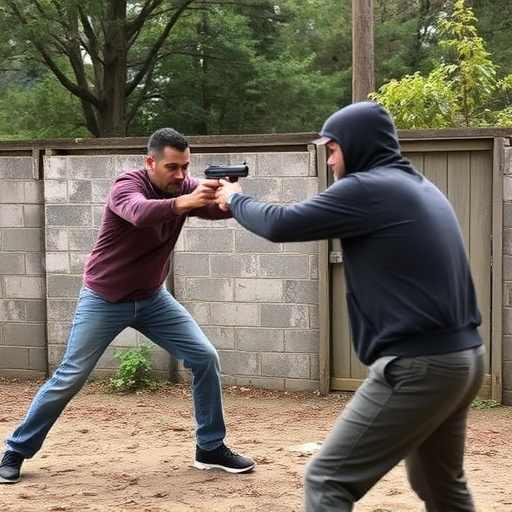OC Spray, a popular personal defense tool, utilizes capsaicin—the 'heat' component of chili peppers—as its active ingredient. Concentration levels, measured in percentages or mg/L, determine the spray's potency and duration of effect. Higher concentrations (1% to 2%) offer more intense irritation but may increase potential side effects. Users should compare these levels to select a product that balances effectiveness with safety. Proper usage involves targeting facial areas at a safe distance, aiming for eyes, nose, and mouth, while adhering to local laws and wearing appropriate gear.
“Personal protection sprays, especially those containing OC spray (Oleoresin Capsaicin), have emerged as powerful tools for self-defense. This article delves into the world of OC spray and its active ingredient, capsicin, exploring its inflammatory effectiveness. We’ll uncover the science behind its power and demystify concentration levels. Additionally, safety considerations and proper use guidelines will equip readers with crucial knowledge. Understanding capsicum’s properties can enhance your awareness of this game-changing personal protection mechanism.”
- Understanding OC Spray and Its Active Ingredient: Capsaicin
- The Science Behind Capsaicin's Inflammatory Effectiveness
- Deciphering Concentration Levels: What Does It Mean?
- Safety Considerations and Effective Use of Personal Protection Spray
Understanding OC Spray and Its Active Ingredient: Capsaicin
OC Spray, a popular choice for personal protection, is a non-lethal self-defence tool that uses capsaicin as its active ingredient. Capsaicin, commonly known as the ‘heat’ in chili peppers, has powerful properties that make it an effective deterrent. When deployed, OC Spray creates an intense burning sensation and irritation in the eyes, nose, and throat of the target, temporarily disabling them.
The effectiveness of OC Spray lies in its concentration levels of capsaicin. This active ingredient is usually measured in percentage or milligram per liter (mg/L). Higher concentrations provide a longer-lasting and more intense effect, ensuring the safety of the user during potential threats. Understanding the capsaicin concentration levels allows users to choose the right spray for their needs, balancing potency with ease of use.
The Science Behind Capsaicin's Inflammatory Effectiveness
Capsaicin, the active ingredient in chili peppers, is renowned for its ability to induce a powerful inflammatory response when exposed to skin or mucous membranes. This effect is due to its interaction with specific receptors in the body’s pain pathway. When capsaicin comes into contact with these receptors, it triggers a cascade of events leading to inflammation. The intensity of this reaction can be attributed to capsaicin’s high concentration levels found in personal protection sprays, commonly known as OC spray or pepper spray.
OC spray formulations typically contain capsaicin in concentrations ranging from 1% to 2%. This concentration is designed to overwhelm the pain receptors, causing a burning sensation and temporary blindness, thus serving as an effective deterrent against aggression. The science behind capsaicin’s effectiveness lies not only in its potency but also in its selective nature, ensuring minimal damage to healthy tissues while achieving its protective purpose.
Deciphering Concentration Levels: What Does It Mean?
Understanding capsaicin concentration levels in your personal protection spray is key to knowing its effectiveness against inflammatory agents. These levels, typically measured in percent or milligram per milliliter (mg/mL), represent the amount of capsaicin—the active ingredient responsible for the heat sensation in chili peppers—present in the spray. Higher concentrations generally mean more intense irritation and repellence, but they also may increase potential side effects.
OC Spray Capsaicin Concentration Levels provide valuable insights into the product’s performance. Manufacturers often share these details to help consumers make informed choices based on their needs. Comparing different sprays’ capsaicin levels allows you to select one that balances effectiveness with safety and comfort, ensuring you’re prepared for potential inflammatory agent encounters.
Safety Considerations and Effective Use of Personal Protection Spray
When using a personal protection spray, such as those containing capsaicin at specific OC spray capsaicin concentration levels, safety should always be the top priority. Always ensure that you and your surroundings meet the necessary safety standards to minimize risks associated with its use. Wear protective gear, including gloves, eye protection, and appropriate clothing, to prevent direct contact with skin and eyes. Keep the spray out of reach of children and pets, and store it in a secure location away from heat sources or open flames. Familiarize yourself with local laws and regulations regarding the possession and use of personal protection sprays, as these vary by region.
For effective use, target areas that provide the best chance of neutralizing the threat. The face is a vulnerable point, but remember that oc spray capsaicin concentration levels should be used judiciously to avoid excessive damage or harm. Maintain a safe distance, typically 2-3 meters (6-10 feet), and aim for the eyes, nose, and mouth of the aggressor. A firm, controlled spray is more effective than a prolonged burst. After deployment, ensure you have enough time to move to safety while the agent takes effect, allowing law enforcement or emergency services to arrive promptly.
OC Spray, driven by its active ingredient capsaicin, has established itself as a potent inflammatory agent for personal protection. The science behind capsaicin’s effectiveness lies in its ability to disrupt cellular membranes and trigger inflammatory responses. Understanding concentration levels is crucial as they dictate the spray’s potency and impact. By knowing the OC Spray capsaicin concentration, users can ensure safe and effective deployment. Safety considerations are paramount; proper training and understanding of usage protocols are essential for mitigating risks associated with this powerful personal defense tool.
